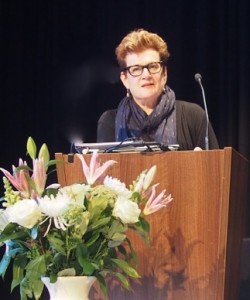On a warm September afternoon, under blue Cambridge skies, Meg Rosoff took to the podium in front of an expectant audience gathered from across the country for the 8th Annual Pearce Lecture.
“We knew when we invited you that you wouldn’t shy away from the difficult questions.” As Louise Joy went on to affirm in her concluding remarks, Meg Rosoff did indeed delight her audience with a lecture displaying a “combination of courage and lyricism”.
In a talk that ranged effortlessly from Goldilocks and the Tooth Fairy to Harry Potter and Albert Einstein, Meg left us in awe – but also inspired and empowered. Starting from her own particular connection with Philippa Pearce, she described how, having first met the octogenarian author as a “fawning middle-aged fan”, she went on to champion Pearce’s The Little Gentleman as a member of the Guardian Children’s Book Prize panel. Since the rest of the panel were not convinced that death was a suitable subject for children’s literature, it did not win. But there in the lecture, Meg felt, justice was done. And so, with humour and humility she examined the vital role of fantasy, fairytale and fear – and their attendant risks – in the lives of children.
Taking her title from a line in Madeleine L’Engle’s A Wrinkle in Time, Meg used her powers of storytelling, and drew on research, literature and personal experience, to demonstrate that fear itself is not the problem. And that, paradoxically, if we shy away from it, we will find ourselves in the grip of another fear – that of failure. Indeed, she observed, some commentators warn that we now have a society raising a compliant generation so fearful of failure they are unable to take risks, to be intellectually curious.
Conversely, as Meg argued, children all need to experience risk, to have the freedom to explore the “What ifs …” Which is precisely what stories of all kinds, from fairytales to young adult novels afford. Richard Dawkins may prescribe “fostering scepticism instead of filling their heads with fantasy”, but imagination – the quality that sets the human species apart – is needed for science as much as for storytelling. As Meg pointed out, for some of the most fantastic stories ever invented, you only have to turn to the spinning tales of multiverses and black holes.
But the message was not only for children and their parents, or for would-be scientists. Talking candidly of the very real challenges in being a writer, and of that “awkward period between novels when the existence of the next book is not a foregone conclusion”, Meg deftly turned her attention to the risk-taking required of the children’s or YA author, who “gives young people the power to shape their own stories”. Again, fiction and fantasy hold the key, and for her it is Dr Seuss’ The Cat in the Hat (“reads like a postmodern anarchist’s handbook”) which supplies the essential image. “I have become my hero; I am the 58-year-old that sneaks into the house and causes havoc,” she revealed. Thus, she ended by issuing her provocation, not to her audience, or to child readers, but to herself: “think big thoughts, and do not be afraid to be afraid”.

